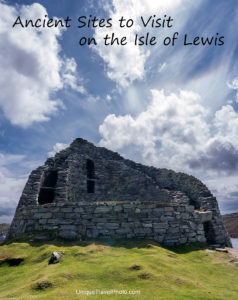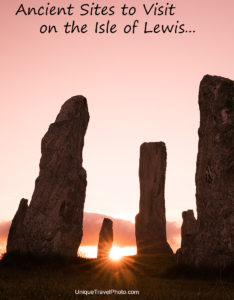Heading to Scotland’s Outer Hebrides, and wondering which sites to visit on the Isle of Lewis?
After visiting here, I can share my itinerary tips & ideas for a perfect day!
Some guidebooks and blogs make it sound really easy to travel between all their recommendations in a single day. It’s just one little island after all! But in real life you’ll become very frustrated driving on these narrow single-track roads (with nowhere to turn around) in a mad frantic dash trying to see everything from the gorgeous beaches in Harris to the Butt of Lewis lighthouse in the opposite northern end. Unless you’re traveling in a hovercraft you’ll miss half the places on your intended itinerary. You simply can’t cram it all in.
So where should you go?
If you’re staying in Stornoway, or the central part of the island, you can easily see these ancient sites in a half day. They’re all located on the western side of the isle in close proximity to each other. So you’ll have time to roam and not rush. The entire loop back to Stonoway is 52 miles and will take 1.5 hours to drive. Plus, I’m including other ideas to round out an awesome day…

.jpg)
Ancient Sites to Visit on the Isle of Lewis:
Callanish Stones ~ 1-2 hours
Perched on a hilltop, the Callanish Standing Stones are Scotland’s most impressive, important site in the Outer Hebrides. Famous world-wide! Full of mystery and intrigue, nobody knows who built them or why. Older than Stonehenge, this ancient stone circle is not roped off, fenced off or closed after dark. This 5,000 year old attraction is open to tourists for free.
And the best part? You can wander freely among them—all day or all night!


And you can even touch them.
Get close. Reach out and lightly trace your fingers over the textures and patterns. Notice the glint of quartz and hornblende crystals in these ancient gneiss rocks. Some of the oldest in the world.
Then stand back and note the linear formations that protrude from an inner circle. The whole formation is in the shape of a Celtic cross. Obviously predating Christianity, why were they put here?
Walk around the 13 stones in the inner circle and linger at the tallest stone in the very center–incredibly 32 feet tall– and let your mind wander to a time long, long ago…a mysterious time when the stones were a sacred meeting place for rituals, perhaps pagan worship, solar tracking, lunar tracking, or even transport for time travel if Claire really did get through these stones to her Jamie (right, Outlander fans?).


There’s something almost eerie walking around when no one else is there. Especially in the dark. Feeling vulnerable, dwarfed by 49 towering stones, and staring up at some that seem to have stoic faces, it’s easy to let your imagination go—thinking about the people who performed rituals here for over 2,000 years—so long ago.
In the dark you can picture secret ceremonies of hooded men huddled in the center configuration near the tallest stone. Or locals who gathered with anticipation under a full moon to witness the “shining one” who appeared on that special night that only happens every 18.6 years. Or the farmers keenly watching the passage of light hitting the stones, who were ‘reading’ the lunar or solar predictions that would affect their crops.

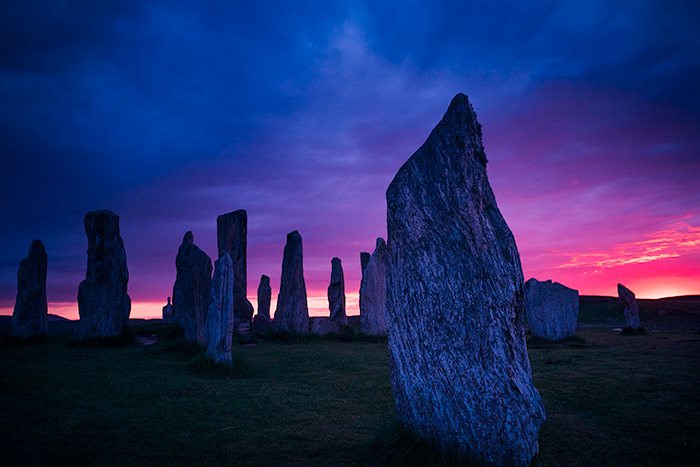
Dark is my favorite time to be at the Stones. So I encourage you to come pre-dawn if you can, or come back again at the very end of your day to see at their most mysterious.
Nearby the main site, Calanais I, are other standing stones sites, Calanais II and III. Quiet spots, with few visitors. But they only have fewer and shorter stones in comparison. Wear Wellies if you decide to go for a boggy walk to investigate them at the bottom of the hill. Inquire at the Visitor Center for specific directions and info about the other circles that number all the way to Calanais X. Calanais III (pic of sign) is just down the road from the carpark.


The Visitor Center has a small exhibit and short film “Story of the Stones” for a small fee, restrooms, a cafe for coffee, soup, sandwiches and homemade bakery items, plus one of the best souvenir shops on the island. You can buy Harris Tweed items, locally made crafts, jewelry, paintings, books, and Gaelic & Celtic music CD’s. (Love my necklace with a gneiss pendant from here.) Open June-August daily, except Sundays, 9:30am-8pm. November to March open 10am-4pm, closed Sunday & Mondays. Rest of the year open 10-6pm, closed Sundays.
Just to clarify—the Visitor Center has limited hours and is always closed on Sundays, but the Stones are always open, and completely free to visit.


Getting here
This is a popular attraction and one of the few sites that have a regular shuttle service for £25 from Stornoway. Minibuses arrive at the Callanish site at 10am, 12, 2pm and 4:30pm. Large tour groups traveling by coach also visit at various times during the day (but only stay 30-45 min at this important site).
If you’re leaving from Stornoway, plan on a 25 min drive across the island. Directions: Drive southwest on A859 for 8.7 miles, then merge onto A858 for another 6.6 miles before turning left at the brown Calanais sign and follow the narrow road the last 2 miles to the Visitor Center. Alternatively, you can drive straight up the hill to the stones and save yourself a walk at night.
Wanna stay closer? You can stay in a guesthouse or rent a cottage near the Stones like we did. We rented a lovely farmhouse in Breasclete, a 5 min drive away (allowing us to visit multiple times).
Itinerary tip
You do want to get here before the tour buses unload.
Even if you’re not into photography, consider arriving in the wee hours of pre-dawn to see them in the soft morning light when skies may be peach or pastel blue tinged with pink. Or eerie gray with dark swirling clouds. This is the time of day when these giant slabs of ancient gneiss stand out best and take center stage. They may look regal, commanding or foreboding depending on the color and mood in the sky. It’s a great time to photograph them. And to watch the drama unfold as the first rays of sunlight hit these silhouetted shapes, gradually illuminating them in the rising sun.
Or, visit them in the day to get a good orientation of the layout, go through the little museum at the Visitor Center, and come back after dark to capture the sunset (see my Callanish sunset post or my Callanish photo tips post). And stay awhile after everyone disappears to soak up the spooky atmosphere.


SUNRISE & SUNSET
Be forewarned that sunrise in summer is extremely early — 4:20am in mid-June. So if you’re planning a trip to the Isle of Lewis in early summer consider checking out the Visitor Center during open hours and coming back after dinner to catch the 10:30pm sunset. There were remarkably few others during our June visit. And if you stay out past sunset, chances are you’ll be alone with the stars. Trust me, the spookiness of being surrounded by these silent giants in the dark will fuel your imagination!
In contrast, if you visit mid-March, sunrise occurs at 6:41am and sunset 6:30pm, not such ungodly hours. And you if you stay out late this time of year you may get lucky and witness the Aurora Borealis making a special appearance. Imagine sitting in the midst of these fantastical stones mesmerized by pulsating wisps of green dancing overhead! Check out the sunrise and sunset times for the Isle of Lewis to plan your visit: timeanddate website.
Dun Carloway ~ 1 hour


Oh, that sky! Those clouds! A perfect day for exploring. And what a striking location for this commanding broch.
This was one of my favorite sites to visit on the Isle of Lewis…
Brochs–unique to Scotland–only exist in the far north and west. Their exact purpose is debated–a defensive fortress seems likely, but most experts believe they were built as status symbols for important families in the community, dating as far back as the 1st century BC.

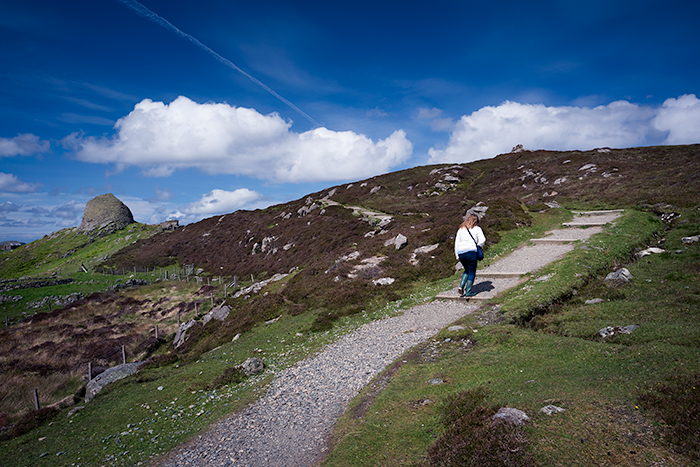
From the car park, follow the short uphill path. Go through the metal gate designed to keep sheep inside the fenced property from neighboring crofts.

 Don’t forget to stop and appreciate the panoramic view of the broch towering over Loch Carloway in the distance.
Don’t forget to stop and appreciate the panoramic view of the broch towering over Loch Carloway in the distance.
Originally the tower walls were 43 feet tall. Thanks to erosion since the Viking days, the walls are 30 feet high in our lifetime.

 Time to explore!
Time to explore!
Entrance to this broch is through a single opening. Open the little wooden gate and crouch under the stone to enter. Standing in the courtyard, open to the sky, note the small openings in the walls. One was a guard cell used to protect the inhabitants from unwelcomed passage.
Inside this courtyard are 4 openings leading to spaces within these hollow walls. Two led to private rooms, another a staircase and one a storage bin?
Livestock lived on the ground floor, and families lived above them. Living quarters included raised hearths on wooden floors that once divided this broch into 2-3 stories based on findings from the archaeologists who unearthed ash, pottery, fragments of posts and hearths dating from 400-700AD during excavations carried out in 1972. Walls tapered slightly inwards as they ascended upwards to prevent them from being too heavy and tumbling over from strong westerly winds. Thatched roofs on animal skins stretched over wooden beams once covered the tower.

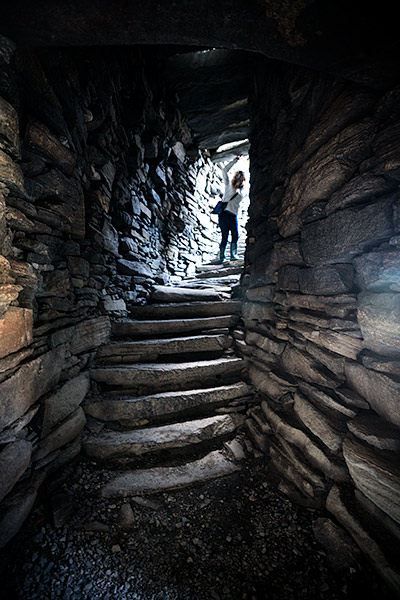 Architects of these ancient brochs designed double circular walls to withstand the elements. Perhaps the most interesting feature at Dun Carloway is this ancient stone staircase leading up inside the tower, enclosed between these hollow stone walls.
Architects of these ancient brochs designed double circular walls to withstand the elements. Perhaps the most interesting feature at Dun Carloway is this ancient stone staircase leading up inside the tower, enclosed between these hollow stone walls.

 Builders used dry stone masonry, a construction technique that fit rocks snugly together without using mortar. It’s remarkable to realize that this structure– built over 2,000 years ago– still exists. Especially when you stand on top of this exposed hilltop and feel the blustery, lift-you-off-your-feet Atlantic winds!
Builders used dry stone masonry, a construction technique that fit rocks snugly together without using mortar. It’s remarkable to realize that this structure– built over 2,000 years ago– still exists. Especially when you stand on top of this exposed hilltop and feel the blustery, lift-you-off-your-feet Atlantic winds!


Stones from these ancient brochs were pillaged to construct blackhouses in later centuries. And sometimes it was used as temporary shelter. There’s a story about the Morrisons of Ness who stole cattle from the MacAuleys in 1601, and hid here. But the wise Don MacAuley found them, ascended the roofless tower by climbing up the steel blades of his daggers that he lunged through the exterior stones. And, once reaching the top, successfully smoked out the inhabitants by throwing heaps of burning heather on them.
In early 19th century portions of the wall fell away. That’s when Historic Scotland stepped in and restored Dun Carloway in 1887, and opened it up to tourism. Aren’t we glad they did?
This site is free to visit.
Make time to stop in the tiny Visitor Center (open during summer months) to walk through a darkened room where sounds enhance the model displays of what life may have looked like eons ago. Restrooms and a small selection of souvenirs are also here. (I bought a cute striped woolen cap that kept me warm on this windy isle! Yep, that’s me wearing it at Callanish.) The friendly local manning the center was busy sewing fabric eyeglass cases (£1) to pass the time.


Getting here
From Callanish, keep traveling north on A858 for 6 miles, about 11 minutes. As you pass through Breasclete village, you may want to stop at the Hebredian Soap Company to buy local soaps made from heather and other plants from the isle. Note the Dun Braes Hotel on your left as you leave town and continue driving north–this is the only place we found open for dinner in the entire surrounding area during our stay. Excellent food, especially tasty soups and friendly service in both the tavern and restaurant. Look for the brown historic site sign Dùn Chàrlabhaigh, turn left and follow the road to the parking lot .5 mile. If you’ve reached the town of Carloway you’ve gone 1.5 miles too far.
Itinerary tip
Allow about an hour to visit. If bright skies are cloudless and sunny, the conditions will be too harsh for great pictures as the light will be too contrasty. Weather changes quickly and clouds often roll in. So keep that in mind if you’re planning on returning to Callanish stones late this afternoon or evening and consider stopping here first to capture them in better light. Clouds are desirable to diffuse the severity of sunlight which allows you to capture textures up close or panoramic landscape scenes without losing detail.
Gearrannan Blackhouse Village ~ 45 minutes


Nine stone blackhouses sit in a pretty bay on the Atlantic coast. These were the traditional homes in the Scottish highlands hundreds of years ago. Long rectangular structures, they were built similarly to the brochs with dry stone construction and double walls.
Original homes didn’t have chimneys–which sounds alarming when you hear that they kept a fire burning in the central living area at all times. Apparently most of the smoke escaped through the thatch in the roof, which blacked with layers of soot. This thatch was then stripped from the house every year to use as fertilizer on the crops. And roofs replaced.
Eventually health regulations forced families out of their blackhouses. Not because of health concerns over smoke, mind you, but because of sanitation concerns over living with animals. Yes, these long rectangular blackhouses were built to accommodate livestock at one end, and people in the other. Hmmm…smoky, sooty and smelly?
Peat
Talking about smell, I must mention their heat source. Peat, cut from the earth, fueled the fires. It has a distinctive smell, and locals seem to love it. Many still use it to heat their homes today. Why not? Free energy!


If driving around the island in the springtime, you will surely see locals cutting peat. And if visiting in the summer, see them stacking peat bricks to dry in the wind. We followed our landlords out to their plot to learn more about process. Dave even joined in. Cutting, lifting and stacking the peat bricks is slow, grimy, back-straining work!


As a visitor to Gearrannan village, you’ll learn about this through a film included in your admission. It also introduces you to the process of weaving Harris Tweed. Now back to the blackhouses…
In the late 1800’s, most inhabitants moved out of blackhouses and into modern “white houses” that were constructed with mortar. But not all. Some people refused to budge and lived in their blackhouses until the 1970’s–but many of these had fireplaces with chimneys, such as those at at Gearrannan village.


The blackhouse on display at Gearrannan village was occupied until the 1960’s. Visitors can walk through this home and see the kitchen furnishings with stoneware, and typical boxed beds, curtained for privacy.

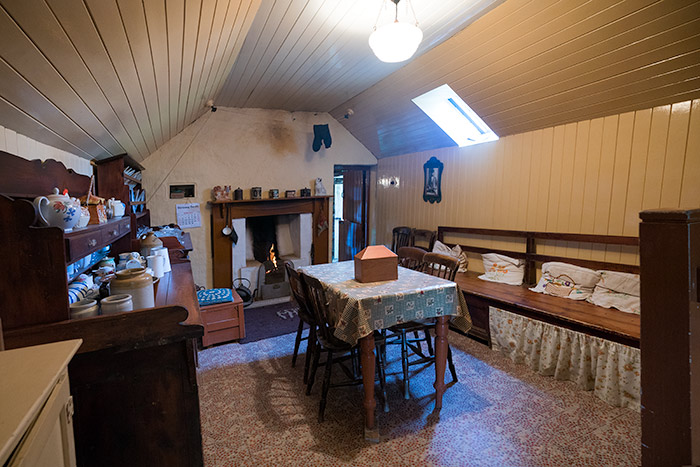
Both rooms have fireplaces which replaced the original central fire pit that once burned all day and night. It just looked like an old house to me with painted walls and doors, and even had electricity.

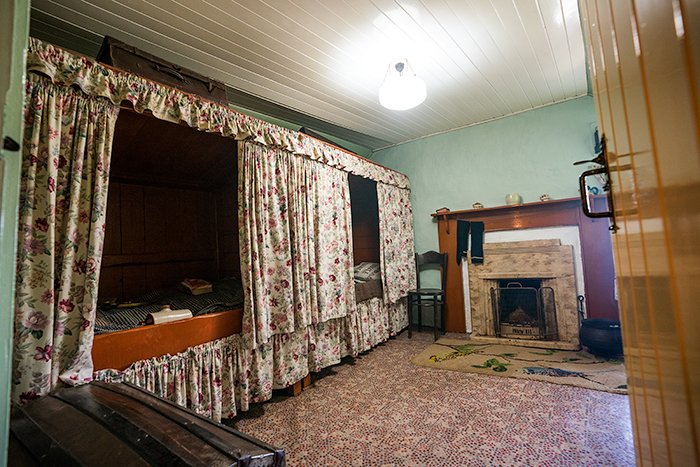
The other end of the blackhouse is where animals were kept, and equipment in a barn. Now this looks more like I imagined a blackhouse would look –with stone walls and thatched roof. Super rustic.

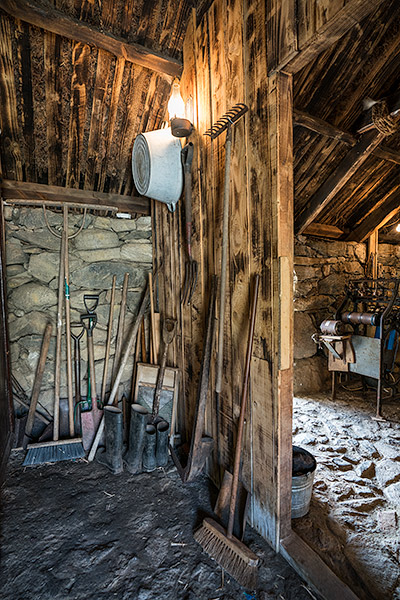
Most blackhouses also had a looming shed to weave wool. This antique Hattersley loom is not only on display but sometimes has a weaver to demonstrate the process to create Harris Tweed.

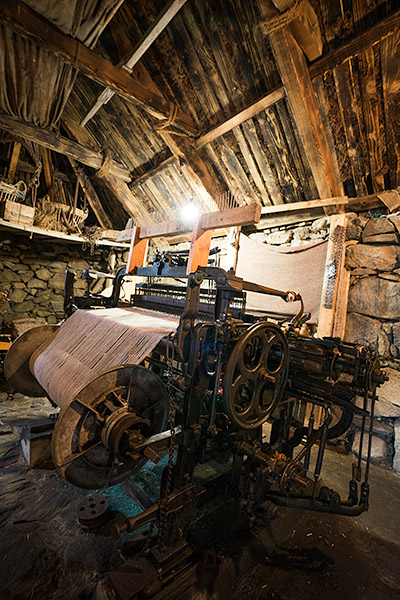
Getting here
The location is close to Dun Carloway, just 10 minutes away. Drive north 1.7 miles to Carloway village, turn left at the sign (picture) and follow that road for another mile.


Itinerary tip
Despite the fact that this is a “village” your time will be quite short here as there is only one blackhouse for tourists to walk through. Plus another room where you can watch a short film about weaving and peat cutting. But your visit could take longer if there’s a weaver present to demonstrate the loom (nobody there during our visit) or if you decide to eat in their cafe. We chose to eat lunch there since it had ample seating available when we arrived. Yet it was 20 minutes before our waitress brought menus and another 40 minutes waiting for our food—which was pre-made egg salad sandwiches– made with something called Salad Cream which is not akin to mayo–just sayin!
If you’re keen on stretching your legs you could hike part of the coastal trail that heads north to Dalmor Beach. Just be very cautious of the steep cliffs.
Fancy staying here? Well you can! Unique about this site is that most of the Gearrannan village blackhouses are rented out as self-catered modern lodging. They have 3 blackhouses for rent that sleep 2 people or a family of 4-5, and a long blackhouse that has 14 bunks. For lodging information, check out their website.
Alternatively, Historic Scotland operates another Blackhouse tourism site further north that you can visit. Arnol Blackhouse is 11 miles north, up past Shawbost on A858 road (see above map). A peat fire burns in the center of the living space in their blackhouse that you walk through, and a newer 1920’s white house sits next door for comparison. Both charge admission. Admission fee is £3.50 per person.
Other Sites to Visit on the Isle of Lewis:
Afternoon Ideas & Lunch Break
By now you’re getting hungry and eager to stop for lunch. I was going to recommend North 40 in Bragar (north of Dalbeg Beach), but I see online now that it is permanently closed! No idea why. This really is unfortunate. It had such wonderful food and staff. And there’s really no where else to eat around there. Restaurants are far and few between destinations on this island.
So…either eat lunch in the Gearrannan Blackhouse cafe or pack a picnic lunch of smoked salmon purchased in advance from the Stornoway Smokehouse shop (located near the ferry port on the harbor) and have a picnic at one of 2 nearby beaches.
Dalbeg Beach ~ 30 minutes to a couple hours?

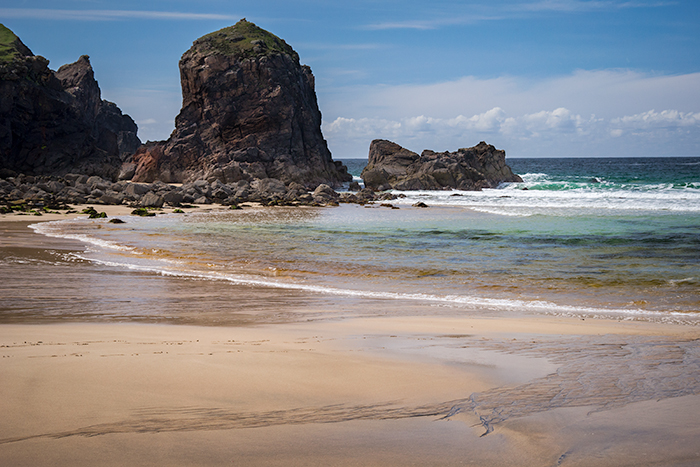 I just wrote a post about Dalbeg beach so won’t repeat the info here, but suffice it to say that this secluded little spot is perfect for a picnic in a stunning setting, and right off the driving loop.
I just wrote a post about Dalbeg beach so won’t repeat the info here, but suffice it to say that this secluded little spot is perfect for a picnic in a stunning setting, and right off the driving loop.

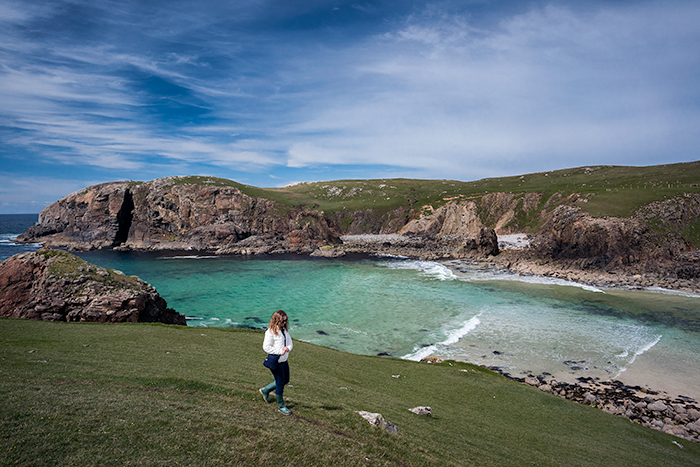
Spend an hour or more exploring the hills to either side of the beach for panoramic views of the dramatic coast where waves crash into rock formations. You can also hike part of the West Coastal Path afterwards if you so desire. Dalbeg is the middle of the trail that begins at the Gearrannan Blackhouse, passes through Dalmor Beach before passing here and continuing north. The trail marker is near the picnic table at the carpark. No restroom facilities here.
Alternatively, Dalmor Beach has restrooms, is a mile closer than Dalbeg and has a wider beach for flying kites and surfing. Same directions, just turn left sooner!
Getting here
Drive 3.5 miles north from Gearrannan Blackhouse on A858, turning left at the sign and follow 1.5 miles to the beach.
Shawbost Norse Mill and Kiln ~ 30 minutes
This is another ancient site to visit on the Isle of Lewis–although full disclosure–we completely missed this short but intriguing little stop. I’m including it here for YOU, pinching myself for not knowing about it while we were there! We must’ve driven right past it too as we were looking for the whale bone arch indicating the turn for the North 40 food shop. (When you’re hangry you tend to have tunnel vision for food.)
A 5 minute walk leads to two beehive-shaped stone buildings with thatched roofs, held down by rocks, that sit side by side in a scenic river valley. One building is the kiln and contains a circular stone pit that dried out grains like corn and barley. The other structure is the mill where paddles ground the grain into flour or meal. During the 1800’s, Lewis had over 200 of these mills. For pictures and more detailed information check out Virtual Hebrides website.
Getting here
It’s just a 6 minute drive north of Carloway, the junction you pass through after visiting the Gearrannan village Blackhouse village. You’ll pass signs for Dalmor and Dalbeg beaches on your left as you keep going north toward the little town of Shawbost (Siabost). Or, from Dalbeg beach, drive 1.6 miles north. Keep your eyes peeled for a brown tourist sign pointing west towards a Norse Mill.
Stornoway


Storoway is the only town on the Isle of Lewis, and the largest town in the entire Hebrides. It has a population of 8,000 people, a busy harbor and even an airport. Depending on your interests, energy level and weather (let’s be real), Stornoway has lots of options. And restaurants! Enough to keep you plenty busy for the rest of the day into evening when you might just be tempted to go back and photograph Callanish Standing Stones after dinner (June sunset is 10:30pm).
Lews Castle
It even has a mock Tudor castle, Lews, that has an outstanding history museum, Nan Eilean. The prized exhibit inside is the authentic 12th c chess pieces that were found buried in Uig sands.

 Lews Castle was built as private residence for James Matheson, who purchased the entire island in 1844. He drained the surrounding moors and imported hundreds of trees to be transplanted here (most of Lewis is flat, barren of trees). Picture below was his ballroom where he loved to dance. Since then castle has become hospital, college and now a hotel. It also houses Nan Eilean Museum, a coffeeshop and cafe. Visitors can explore rooms on the ground floor.
Lews Castle was built as private residence for James Matheson, who purchased the entire island in 1844. He drained the surrounding moors and imported hundreds of trees to be transplanted here (most of Lewis is flat, barren of trees). Picture below was his ballroom where he loved to dance. Since then castle has become hospital, college and now a hotel. It also houses Nan Eilean Museum, a coffeeshop and cafe. Visitors can explore rooms on the ground floor.

 Six of the original Lewis Chessmen dating from 12th century are on display here. (More in the next blog post)
Six of the original Lewis Chessmen dating from 12th century are on display here. (More in the next blog post)

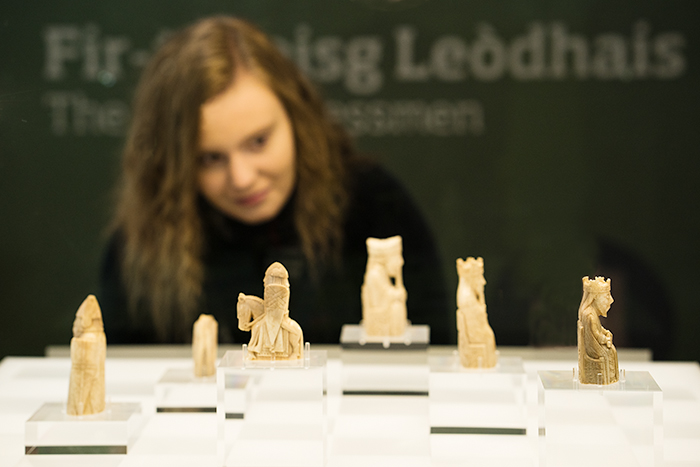
Craving adventure? The wooded castle grounds make a great playground for adults. Rent a mountain bike from Bespoke Bicycles on Lews Castle property and zoom around 16 different forested trails. Or drive a segway on a guided tour with Segway Hebrides.
Shopping
Wanna shop? Downtown near the harbor, you can browse through shops selling jewelry (hubby bought me a lovely silver ring with a Celtic knot to celebrate our 20th anniversary), art, Harris Tweed clothing and handbags, even the famous Stornoway black pudding… (ewww, I know, but you’ve got to try it!)

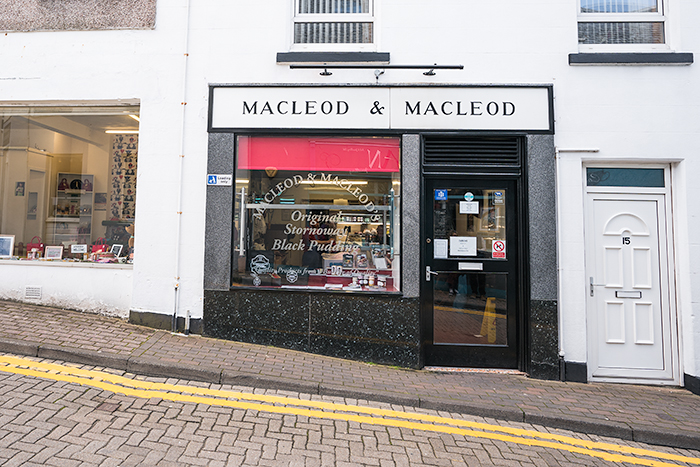
Getting here
Distance from Shawbost Mill to Stornoway is 19 miles, which takes around 30 minutes to drive on A857, a fairly straight road through flat territory.
St. Columba’s Church~ 30 minutes


Want one more idea for ancient sites to visit on the Isle of Lewis? Then check out St. Columba’s. This medieval church, dating from 14th century, is in ruin and missing its roof, but inside you can see ancient tombs from the Macleod clan who once controlled the island. One of the carved graves is the burial place of Roderick Macleod VII (died in 1498) and his daughter Margaret who died just 5 years later.

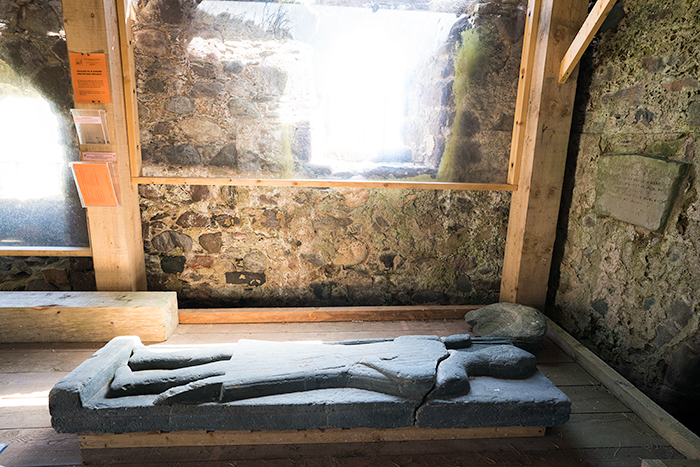
In the surrounding graveyard, there are 19 chiefs buried from the Macleod clan. Descended from Norse Kings, the Macleod clan had two main branches that ruled this island–one in Lewis, the other in Harris. (A later post will cover Rodel church where Macleod clansmen in Harris were buried.)
Getting here
From Stornoway harbor, drive east on A866 for 4.1 miles, around 8 minutes, out past the airport. When you see the ocean close on either side of you, you’re getting close! Begin to look for a blue sign Eaglais na h-Aoidhe (St. Columba’s Church) and turn left.


No Car?
If you don’t have your own car, you could take a whirlwind tour that visit all three sites plus Dalbeg and Bosta beach on a minibus that leaves from Stornoway at 10:30am. Check out Hebridean Tours for more information. Note that tours limit your time to around 30 minutes at each site. But they also provide private tours, allowing you to choose how much time to spend at each site and customizing specific requests.
These were my favorite sites to visit on the Isle of Lewis. Next time I want to explore Bosta beach too. What about you–have you visited here? Which were your favorite places and why?
If you’re looking for a place to stay in Stornoway, check out the Booking.com map below which marks options by place and cost. Zoom in and out to find what you’re looking for…
[booking_product_helper shortname=”stornoway”]
Pinterest lovers…Save a pic to remember which sites to visit on the Isle of Lewis




